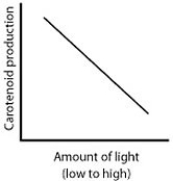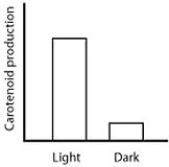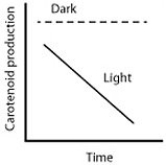Multiple Choice
When microbes are in the dark, they do not produce molecules called carotenoids because the PR proteins are bound to DNA. In the light, however, carotenoids are produced because the PR proteins unbind the DNA. Which of the following graphs best summarizes these statements about carotenoid production in microbes?
A) 
B) 
C) 
D) 
Correct Answer:

Verified
Correct Answer:
Verified
Q65: The recent National Health and Nutrition Examination
Q66: A protein containing more than one polypeptide
Q67: Why did the lactose tolerance mutation in
Q68: Which of the following is a carboxyl
Q69: Propanol and isopropanol are isomers. This means
Q71: A diet high in animal products and
Q72: The storage form of carbohydrates is _
Q73: Many names for sugars end in the
Q74: What is the complementary sequence to the
Q75: Cellulose differs from starch in that<br>A) starch